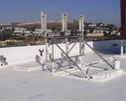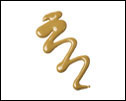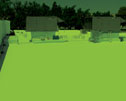NRCA and the National Slate Association (NSA) recently conducted limited fire testing of slate roof systems. If you supply, design or install slate roof systems, I encourage you to be aware of the building code-related circumstances that necessitate this work and the test results.
Background
In the International Building Code, 2009 Edition (IBC 2009), an exception from fire testing in the code's previous editions was removed. The exception waived slate roofs from fire testing to determine their fire classifications. With IBC 2009, newly installed slate roof systems installed on combustible roof decks need to be tested and have a listing of their fire classifications. For additional information, see "New fire classifications," April issue, page 24.
NRCA testing
NRCA retained Underwriters Laboratories (UL) Inc. to conduct fire testing of a representative slate roof system. NSA provided the slate and assembled the test specimens at UL's headquarters in Northbrook, Ill.
The slate roof assembly tested consisted of nominal 1/4-inch-thick slate installed in a random-width pattern over a UL-classified No. 30 asphalt-saturated underlayment that complied with ASTM D226, Type II. The test specimen's roof deck consisted of 15/32-inch-thick APA-rated plywood; the roof deck is a standardized component of the fire test method.
Fire testing was conducted according to UL 790, "Standard Test Methods for Fire Tests of Roof Coverings." UL 790 and ASTM E108, "Standard Test Methods for Fire Tests of Roof Coverings," serve as the basis for determining roof assemblies' fire classifications and are the basis of the familiar Class A, Class B and Class C designations.
The slate roof assembly achieved a Class A designation in NRCA's testing at UL.
Analyzing the results
At first glance, the Class A finding for the slate roof system is not necessarily surprising because slate doesn't burn. However, NRCA is aware of previous fire testing of slate roof systems that resulted in Class B or lower designations.
The known difference between NRCA's fire testing and the previous fire testing of slate roof systems is the underlayment used. In NRCA's testing, a UL-certified, ASTM-spec., No. 30 underlayment was used. A commodity-grade (non-spec.) underlayment was used in the previous testing.
From this, NRCA concluded the underlayment is an important component in determining a slate roof assembly's fire rating.
Code compliance
NRCA conducted this testing for research purposes; NRCA has not sought a UL classification listing for slate roof systems. Such a listing and product labeling would be necessary to provide for direct compliance with the code's fire classification requirement.
However, NRCA's findings can be used to substantiate similarly constructed slate roof systems' fire resistances using the code's alternative approval provisions. For additional information about these provisions, see "Other options," July 2008 issue, page 20.
A copy of the UL report from this testing is available to NRCA members upon written request. NRCA members can e-mail their requests to me at mgraham@nrca.net; fax them to my attention at (847) 544-0813; or mail them to my attention at NRCA, 10255 W. Higgins Road, Suite 600, Rosemont, IL 60018. Similarly, NSA will make a copy of the UL report available to its members.
Thanks to NSA and UL for their cooperation and assistance in this testing.
Mark S. Graham is NRCA's associate executive director of technical services.



